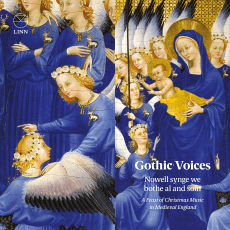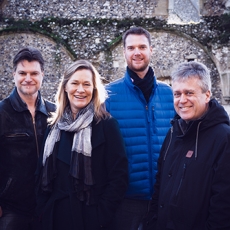Gothic Voices - Nowell synge we bothe al and som - Europadisc
At this time of year there’s a proliferation of Christmas carol services and carol concerts, usually containing a mixture of new or recent works and arrangements with a generous helping of traditional favourites. But how might such an event have sounded six hundred years ago in fifteenth-century England? That’s the brilliant conceit behind a new disc from Gothic Voices, a group renowned for its exploration of early music both sacred and secular from Hildegard of Bingen and Guillaume de Machaut onwards. Adorned by a panel from the vividly-coloured Wilton Diptych (familiar to anyone who’s visited the Sainsbury Wing of London’s National Gallery), this is a glorious collection of works from a period when English music was experiencing its first distinctive flowering. Composers including Leonel Power and John Dunstaple were making waves with a new, florid style of writing that favoured the sweet harmonic thirds and sixths which had hitherto been a scarcity. Their rich soundworld was known on the continent as the contenance angloise (‘English manner’) and was an important influence on such great musical figures as Dufay and Binchois.
It is this fifteenth-century repertoire that dominates the disc, an era when works from earlier times were more of a rarity than newly-composed items. Nevertheless, Gothic Voices happily find room for some jewels from the fourteenth and even twelfth centuries as well as some traditional Gregorian chant to add a liturgical flavour to proceedings. The programme is broadly divided into two parts: Advent, anticipating the coming of Christ as well as the Annunciation to the Virgin Mary from the angel Gabriel, and the exuberant, festive sounds of the feast of Christmas itself.
Proceedings get under way in style with the Advent hymn Veni, O sapientia, sung to a 15th-century French tune well-known from its final verse, ‘Veni, veni Emmanuel’ (‘O come, O come, Emmanuel’), and take on a more jubilant tone with the fourteenth-century Latin carol Angelus ad virginem, with engaging harmonisation from the second verse onwards, and even a chordal drone for the fourth. Works with a Marian theme are plentiful, not least Dunstaple’s splendid quadruple-texted motet Gaude virgo salutata, and there are two nicely contrasting settings of Ave regina caelorum (‘Hail, queen of the heavens’) by John Cooke and Walter Frye. Vernacular works in medieval English include the robustly earthy Nowell, nowell, nowell and the more pensive Mervele not, Joseph.
At the heart of the disc is the haunting fourteenth-century lullaby, Lullay, lullay: Als I lay, a gentle dialogue between Virgin and Child exquisitely sung by mezzo-soprano Catherine King. Other highlights from the Christmas section include the three-voice carols Ther is no rose, the ‘title track’ Nowell synge we both al and som, and the rousing Nowell: Owt of your slepe. A magnificent Sanctus by Power and an animated Gloria by the still earlier Queldryk vividly illustrate the sheer quality and variety of English sacred music of this period. Resonet, intonet, a monophonic conductus from the twelfth century, has a buoyant urgency to it that shows how apparently simply musical means can have a very direct expressive impact.
This marvellously varied programme is rounded off with the joyous carol Nowell: Now man is bryghter, a sentiment the listener will surely agree with by the end of the disc. Whether you’re interested in the early development of a distinctively English musical style or simply want the authentic taste of a medieval Christmas celebration, Gothic Voices’ immensely involving and stylish singing, beautifully recorded in Boxgrove Priory, Chichester, will prove a festive treat. There are excellent notes by tenor Julian Podger (the ensemble’s director), full texts and modern English translations, and handsome presentation. All in all, a uniquely absorbing Christmas disc that really stands out from the crowd.


